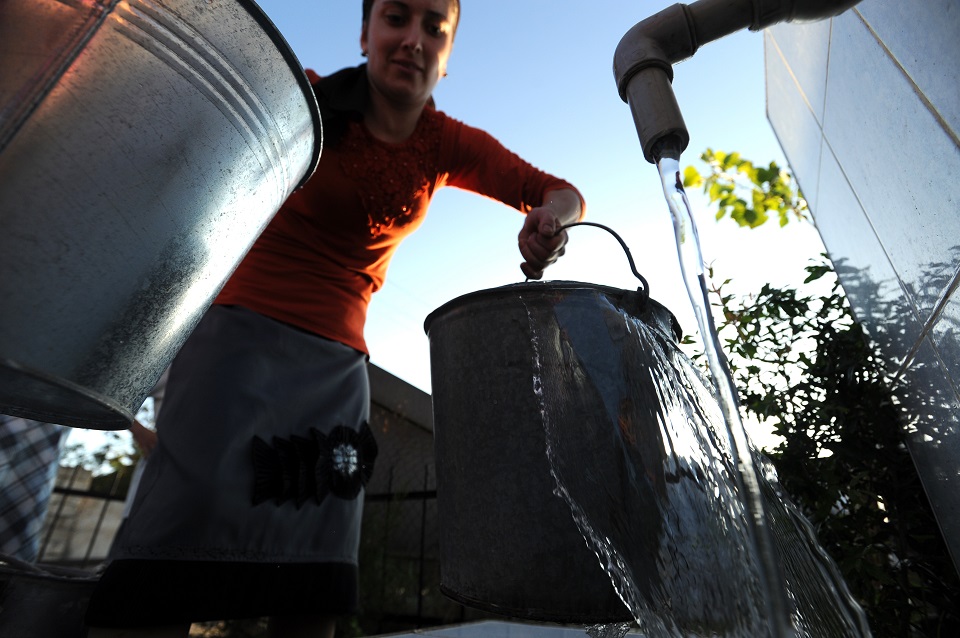
The World Bank has together with UNICEF received 1 bn NOK of the Norwegian aid to water and sanitation. Here a picture from one of their projects in Azerbaijan Photo: Allison Kwesell / World Bank
Marian Willuhn
In 2003 the Committee on Economic Social and Cultural Rights, issued a legal guideline in which they stipulated that the right to water is a human right. In the committee’s assessment the fulfilment of the right to food and the right to health as codified in the ICESCR Article 11 and 12 necessitates the access to clean drinking water and basic sanitary facilities. Naturally Norwegian support earmarked for water and sanitation should operate along those lines and aim at ensuring the unconditional fulfilment of health and basic nutrition.
The volume of the support for water and sanitation projects has varied in the last fifteen years from 126mio NOK in 2011 up to 281mio NOK in 2005. The total combined volume for water and sanitation is around 3.5 bn NOK, making up for about 1% of the total aid budget. Africa and Asia are the prime target areas for water related aid as both received almost one billion NOK over the last fifteen years. The support has been disbursed in different modalities with different recipient channels and effects. NORAD and the MFA decide according to different parameters whether they are disbursing the funds to NGO’s when they would like to have clear policy influence in aid projects that are designed to provide the bare minimum of standards, or make use of multilateral organizations which have more capacities but are less receptive for Norwegian policy input. For more complex projects that go beyond the technical abilities of NGOs funds are usually disbursed to the governments directly which are bound to realize the project through a fair tender, or disburse it directly to a private company. The latter happened to approximately 3% of the funds allocated for water and sanitation aid, while the three other modalities receive approximately 30% each.
Norwegian NGOs vs. International NGOs
Disbursing funds to Norwegian or international NGOs is the most used modality of aid in the water and sanitation sector. 35 % or 1.2bn NOK of the funds for water and sanitation from Norway since 2000 were used in this manner and the Norwegian Church Aid is by far the biggest actor here as it received a total of 567mio NOK in fifteen years. In this modality the funds are allocated to the respective NGO and earmarked for a specific purpose. NORAD and the MFA negotiate a detailed deal with the NGO that goes in line with the overall strategy in that country. For example water and sanitation projects in Afghanistan were predominantly performed by DACAAR (150mio NOK) and NCA (26mio NOK), both of which received their funds according to a frame work which they crafted. The framework states timelines and specific locations for wells and expected beneficiaries etc. In doing so Norwegian development interests and particular policy preferences can be emphasized rather effectively.
Multilateral Organizations
Multilateral organizations such as UNICEF or the World Bank received 1bn NOK (30 %) of the funds from Norway for water and sanitation over the last 15 years and are thus the biggest recipient. They have their own internal structures and only limited opportunity for Norway to push for special Norwegian interests, regarding the outline of aid projects. If Norway, for example, pursues a stronger focus on gender policy when implementing water projects, multilateral organizations could be slightly less concerned with that goal. This differences, however, are usually minor and multilateral organizations are not pursuing policies radically opposing Norwegian policies. At 488mio NOK the majority of the earmarked support from Norway for multilateral organizations goes to UNICEF which works to bring sanitation facilities into schools in line with the WASH principle.
The World Bank received 180mio NOK in contributions over the last 15 year which ranks it the second largest recipient in the modality category. All regional development banks combined received an aid volume earmarked for water and sanitation from Norway of 160mio NOK since 2000. Assessments regarding UNICEF draw an overall positive picture of the efforts. The performance, of course varies between different countries, given the individual situation on the ground, but it is to acknowledge that where WASH has been implemented by UNICEF public health improvements have been recorded. There are, however, issues with implementation of all aspects of WASH, as for example garbage disposal. Such aspects tend to be neglected in order to reach out to more people providing clean drinking water. A report conducted by UNICEF and the EU suggests that UNICEF can increase their efficiency by improving communication between aid agencies of the UN or others in order to be able to coordinate aid better.
WASH
WASH is designed by the UN in relation to the Sustainable Development Goals target six; in theory as a holistic approach which also fosters the building of latrines or similar structures, as well as necessary hygienic education. All of these measures are aimed at preventing death by waterborne diseases or poor hygiene. These operations are aimed at ensuring that even the poorest communities have access to clean drinking water. Owing to weak government structures and severe poverty the programs are tailored for low maintenance costs and communal ownership. Clean drinking water, hygiene education and waste disposal and other aspects that improve hygiene and lower the risk of infections are the core elements of this method. According to NORAD’s internal assessments the organizations have followed the holistic approach with ambivalent success. When funds were scarce the organizations prioritized building new wells over building facilities to combat open defecation.
While the access to clean drinking water seems to be the naturally more important element, the devastating effects for public health of open defecation should not be underestimated. Diarrhoeal diseases are caused by this practice and for children often culminate in death. In part it was also criticised that villagers had received latrines and wash basins without training on how to use them or education on why to use them. Subsequently those hygiene facilities were not used and thus a sustainable positive effect on public health could not be attained.
Direct cooperation with recipient government
Direct cooperations with governments make up for 24% of the water and sanitation earmarked support of the last fifteen years which amounts to 812mio NOK. It is possible that NORAD and the MFA favour this kind of modality when two criteria come together. Seeing that in every case of such modality the projects involved the building big comprehensive water systems, like piped water systems and modern waster-water treatment plants for entire cities or regions, the conclusion lies near that NGO’s and MLO’s are not usually the favourable partner for such projects. The reasons for that are not disclosed, though one can imagine that the building of an entire infrastructure goes beyond what most NGO’s are specialized in. Owing to the fact that this kind of modality of aid funds would be granted to a ministry which then in turn opens a tender process and allocates the aspired task to the best bidder, it is also possible that NORAD and the MFA refrain from cooperating on such level with governments that have very little control over corruption in their branches.
For example Afghanistan, which is infamous for its high level of corruption had not received any support of such kind for water and sanitation. Afghanistan did, however receive direct contributions to the ministry of education, but as was condemned by NORAD funds earmarked for the building of schools, have literally vanished, effectively discouraging a continuation of support of such kind.
Private sector support
Around three percent of the funds are allocated towards the private sector which adds up to a total of 1.5mio NOK in fifteen years. Most of which has been spent around 2006 in Bosnia and Albania in order to strengthen the private sector to boost the economy. At that time both Bosnia and Albania suffered from very poor economic performance that resulted in high child mortality malnutrition. European donor consortiums came to the conclusion that sustainable aid can be achieved by improving the, at that point, very weak infrastructure of the countries in order to attract businesses. Unreliable water supply and power cuts were found to hinder economic activity especially in the rural regions. The World Bank and a consortium of donors then favoured a water infrastructure privatisation approach.
Concluding remarks
The review of water and sanitation aid from Norway tells a story in which Norway focuses heavily on the WASH segment by either funding multilateral organisation or its own NGOs to perform WASH programmes in the most severely poor areas in the world. Though there are issues that need to be addressed in order make this type of aid more effective it can be said that positive impacts, where programmes were active, are evident. The vast majority of the projects refrain from public ownership while attempting to strengthen communities and women’s rights. Efforts regarding behaviour change should be reviewed as several reports point out how ineffective such efforts often are.
Furthermore a more integrated holistic approach is necessary if the aim of significantly improving public health in the target areas is to be attained. Not providing adequate solutions for excreta or garbage disposal or hygienic education jeopardises the positive health effect of a wash basin or fresh water well. In line with this goes the fact that Norwegian NGOs should be more flexible in their way of approaching the communities and take certain aspects that are particular to that community better under consideration. This can improve the receptiveness for education or avoid the provision of unsuitable material. The assumption that the aid through NGO’s and MLO’s is determined to bring most immediate human rights relief where it is most acutely needed, renders this type of aid utmost important. The combined aid for MLO’s and NGOs makes up for 65% of the aid volume for water and sanitation and it is thus evident that NORAD and the MFA put a significant importance on this issue.
While it is a correct assumption that the lack of a functional infrastructure hinders economic activity which was needed in Bosnia and Albania, it is questionable whether a privatisation of the water systems was necessary and the most helpful solution. Norway’s involvements into water privatisation operations are limited but FIVAS thinks should not happen at all. Water privatisations are almost irreversible and cannot promise the efficacy and transparency a well run state company could provide. The paradigm for Norwegian water aid according to us should be to foster community ownership. As water privatisation often is contrary to development aid targets it should be clearly disfavoured by NORAD and the MFA.

